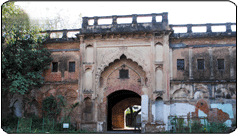Badshah Bagh
Students who celebrated the advent of Spring (Basant) on the main campus of Lucknow University recently, were probably not aware that they were enjoying the fun at nearly the same place where the second King of Awadh, Naseer-ud-Din Haider (1827-1837) celebrated the Basant mela [fair] with great fun and fanfare with items like the Meena Bazaar (organised for women with stalls manned by females). Competitions in classical music and dance and presentation of mimicry and skits by bhand (mimics) from Kashmir were also held. The three day Basant mela was held at the royal gardens developed by Naseer-ud-Din Haider for his favourite queen Qudsia Mahal. It was known as Badshah Bagh and extended from Hasan gunj at one end to Iradat nagar on the other end (Iradat nagar today lies behind the Dali gunj Railway station and Hasan gunj is adjacent to Chand gunj).
The Lucknow University main campus today is located in just a small portion of Badshah Bagh. In fact it is the third venue of this educational institution which started as a school in a palace in Aminabad on May 1, 1864 and promoted two years later as Canning College, it was shifted to the Pari Khana at Qaiser Bagh. Maharaja of Kapurthala who purchased the Badshah Bagh from the British government [at an auction] for a throwaway price of Rs.35,000 after the Mutiny (freedom struggle), gave 90 acres of the garden land to Canning College on lease (with just Rs.3 as annual rent). It later became the Lucknow University in 1922.
Some details of the short period of the prime glory of Badshah Bagh are available from the accounts of Fanny Parkes, a French lady [who visited the gardens in 1831] and Sheikh Azmat AN Nami of Kakori, a contemporary chronicler. They speak of an ochre coloured Baradari with white marble pillars and chequered floor at the centre of the royal gardens, along with the zenana quarters for the royal ladies and a grand square house near the Jilo khana.
The high walled garden also had two gateways. A wide canal flowed in front of the Baradari which was filled with rose-scented water and small coloured fishes were seen gliding or leaping through its clear white sparkling waters. [A pretty small bridge was placed over the canal]. The beautifully laid flower beds contained a variety of plants and bushes and had their floored walks (paths) illuminated with silver lanterns in the evening. The lanterns were fixed to bright coloured lamp posts.
Badshah Bagh also served as a mini zoo with different varieties of singing birds and rare birds not generally seen in this area along with wild animals retained in beautiful cages or enclosures for the delight of visitors. Small animals like rabbit, white mice and furry squirrels moved playfully as pets on the green lawns of the gardens. Often partridge and cock fights were held for the pleasure of visiting guests.
The contemporary writers appear much impressed by the female gardeners (maalin) who were in majority amongst the five hundred or so employed at the Badshah Bagh. They were given two sets of different coloured garments each week, with strict instructions that no old dresses were to be worn on duty. The maalin had silver handles fixed on their gardening implements and the chief of maalin had them studded with jewels.
Badshah Bagh also witnessed the tragic suicide of the Queen Qudsia Mahal, who was just twenty-four years old at the time. Thereafter Badshah Bagh lost its attraction for the King.
Badshah Bagh also played a very important roie in the freedom struggle of 1857-1858
Source:
Hindustan Times, City Scan, A Time in History
Wednesday 31.3.1999 — Badshad Bagh ; where spring blooms

